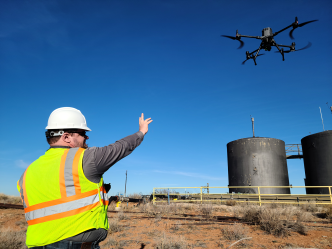UPDATE: The EPA Final Rule has been published in the Federal Register, starting the 60 day clock for compliance. The Final Rule effective date is May 7, 2024.
On December 2, 2023, the United States Environmental Protection Agency (EPA) finalized a rule that will update and strengthen standards for methane and other air pollutants from oil and natural gas operations. Publication in the Federal Register is anticipated in the near future.
NSPS SUBPART OOOOb
This final New Standard Performance Standard (NSPS), codified as Subpart OOOOb, will affect oil and gas facilities that commence construction, modification or reconstruction after December 6, 2022. Affected facilities with updated standards include each:
- Well affected facility;
- Centrifugal compressor affected facility;
- Reciprocating compressor facility;
- Process controller (previously “pneumatic controller”) affected facility;
- Storage vessel affected facility;
- Process unit equipment affected facility;
- Sweetening unit affected facility;
- Pump affected facility; and
- Fugitive emissions components affected facility.
Some equipment or processes not previously regulated include:
- Compressors at centralized tank batteries;
- Liquids unloading;
- Associated gas from oil wells;
- Pneumatic pumps;
The final rule addresses “super-emitter events”, i.e. an emissions event detected by a certified third-party notifier, using remote detection methods resulting in large leaks and releases. EPA expects this final rule to reduce many sources of super-emitter events.
The final rule also includes final updates to the protocol, referred to as Appendix K, for using optical gas imaging (OGI) for leak detection. These final Appendix K updates address conducting surveys, training, audits, and OGI camera requirements and operator qualifications.
EG SUBPART OOOOc
The EPA’s new Emission Guidelines, codified as Subpart OOOOc, significantly revises the regulatory framework for greenhouse gas emissions from existing crude oil and natural gas facilities. This update is a part of the EPA’s broader initiative to reduce methane emissions, with the aim of achieving an 80% reduction in methane emissions by 2038. The new rule, applicable to existing facilities that commenced construction, modification, or reconstruction on or before December 6, 2022, encompasses a wider range of emission sources and mandates increased monitoring and reporting requirements.
The implications of these changes are significant for the crude oil and natural gas industry. Facilities will need to adapt to more stringent monitoring and reporting requirements, implement zero-emission technologies for certain equipment, and possibly modify storage and operational practices. This could potentially lead to increased operational costs and the need for technological upgrades. However, it also represents a major step towards reducing greenhouse gas emissions and mitigating the impact on the environment.
Subpart OOOOc gives States and Tribes two years to develop and submit methane reduction plans for existing sources and three years from plan submission date for designated facilities to comply.
Compliance with these new regulations will be crucial for the continued operation and sustainability of these facilities. Please contact the SWCA Air Quality team if you have any questions regarding the applicability, requirements and compliance options of NSPS Subpart OOOOc to your specific facility.
WILL MY PROJECTS BE AFFECTED?
Facilities must be in compliance with these standards as early as 60 days after the final rule is published in the Federal Register, with longer periods allowed depending on type of equipment and method of compliance.
UPDATE: The EPA Final Rule has been published in the Federal Register, starting the 60 day clock for compliance. The Final Rule effective date is May 7, 2024.
SWCA CAN HELP

The final rule does recognize and encourage innovation and provides owners and operators the flexibility to use a range of advanced technologies to identify leaks and reduce methane emissions.
SWCA’s data acquisition and air quality services include precision airborne leak detection and fugitive emissions monitoring via drone-mounted sensors, applicability determinations of GHG and VOC standards, and comprehensive compliance program, including strategies, compliance options, and regulatory due dates. Current technology deployments enable us to detect greenhouse gases emitting at 5 parts per million/cubic meter and greater.
These remote sensing capabilities provide numerous efficiencies, including comprehensive coverage of large areas containing hundreds or even thousands of assets, with less manpower and resources than standard fixed location or terrestrial detection methods. We see the implementation of these services as a way for companies to get ahead of anticipated compliance needs, specifically Subpart OOOOb.
Please contact SWCA’s nationwide experts if you have any questions regarding the applicability, requirements and compliance options of NSPS Subpart OOOOb and Emissions Guidelines Subpart OOOOc to your specific facility.
bsohm [at] swca [dot] com (Brad Sohm) | Director, Air Quality Services
SUrwick [at] swca [dot] com (Scott Urwick) | Senior Business Line Director, Oil & Gas
KShockley [at] swca [dot] com (Kayla Shockley) | Senior Project Manager
